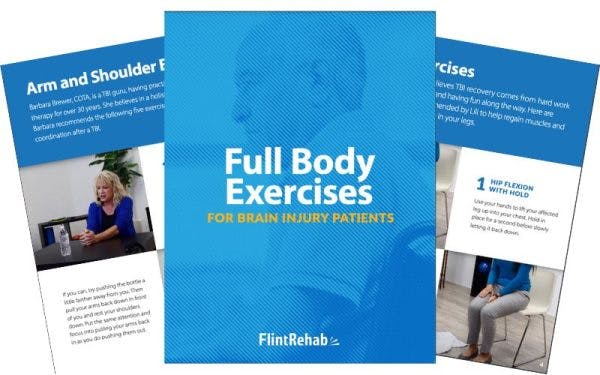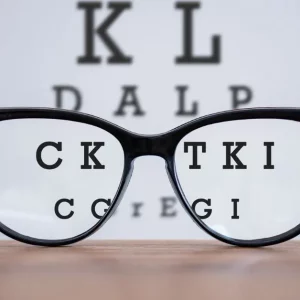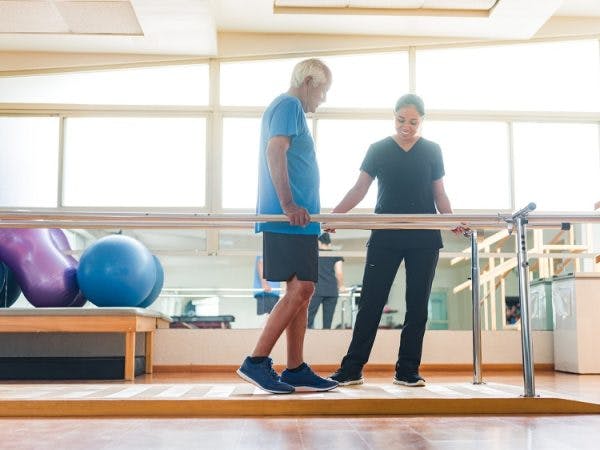Dizziness after a head injury is a common occurrence. In fact, between 30-65% of survivors experience vertigo or imbalance at some point during their recovery. In addition to being unpleasant, dizziness can impede an individual’s ability to move around safely. Often, dizziness is relatively short-lived and will naturally fade. However, if it does not, there are a number of therapeutic treatments that may address it.
In this article, the most common causes of dizziness after head injury will be discussed, along with effective treatment and management techniques. Please use the links below to jump directly to any section of this article.
Common Causes of Dizziness After Head Injury
Dizziness is a broad term that can capture a number of different experiences. For example, individuals that experience dizziness after head injury due to vertigo may feeling as though they are spinning. Others may experience dizziness due to disequilibrium, or the feeling of being off-balance or tippy. Furthermore, light-headedness may also be referred to as dizziness.
Each type of dizziness has a different cause, and therefore requires specialized treatment. Some common causes of dizziness after head injury include:
- Inner ear problems
- Migraines and other headaches after brain injury.
- Medications, such as blood pressure or anti-seizure drugs
- Dehydration
- Pinched nerves in the neck
- Damage to the cerebellum, the part of the brain responsible for balance
- Damage to the occipital lobe, the part of the brain that controls eye movement and vision
- Low blood pressure
Individuals experiencing dizziness after head injury should clearly describe their experiences to their doctor or a physical therapist specialized in vestibular dysfunction for an accurate diagnosis. Understanding the type of dizziness and its cause is essential for developing an effective treatment plan.
Want 20 pages of brain injury recovery tips in PDF form? Click here to download our free ebook “15 Things Every TBI Survivor Must Know” (link opens a pop up for uninterrupted reading)
Dizziness and the Vestibular System
The body has a number of systems that contribute to maintaining a sense of balance, including the vestibular (sense of balance), proprioceptive (sense of body position), and visual systems. Damage to any of these systems, particularly the vestibular system, may cause dizziness after head injury to occur.
The vestibular system works to enhance balance by detecting the motion and position of the head in space. The inner ear, including the semicircular canals and otolith organs, play a vital role in this.
The semicircular canals are three, fluid-filled tubes lined with tiny hairs that monitor head motion. When the head moves, the fluid within the semicircular canals also shifts, moving the tiny hairs. This allows the brain to detect motion.
The otolith organs have a similar function, except they respond more to gravitational force. For example, the crystals inside these organs can detect when the body is moving up or down in an elevator.
After a head injury, the vestibular system may be impaired, causing dizziness and other balance issues. This can happen in a number of ways, including:
- The crystals in the otolith organs can dislodge, which will result in impaired balance. This condition is referred to as Benign Paroxysmal Positional Vertigo (BPPV).
- The fluid in the inner ear can leak into the middle ear.
- The nerve connecting the vestibular system to the brain can become damaged.
Damage to the brain regions responsible for balance can also cause dizziness. Determining the cause of dizziness after brain injury can help individuals seek appropriate and effective treatments.
Treating Dizziness After Head Injury
After identifying the root cause of dizziness after head injury, there are a number of treatment and management strategies that may be recommended. However, sometimes the cause of dizziness may be challenging to determine. Therefore, it is crucial to receive an examination from a vestibular specialist or physical therapist.
These medical professionals will perform a series of tests, such as vision and balance assessments, to determine if dizziness issues are stemming from the inner ear or elsewhere. Based on the results, they can create a customized treatment plan, with personalized exercises to address an individual’s specific impairments.
The following treatments may be recommended to address dizziness after head injury:
1. Gaze Stabilization Exercises
The vestibular and visual systems are closely linked through connections such as the vestibulo-ocular reflex. Through this reflex, the vestibular system can trigger the eyes to make small adjustments to maintain a stable gaze, even when the head is moving. After a head injury, this reflex can become damaged, resulting in disorientation and dizziness.
Specific eye exercises, such as gaze stabilization exercises, are designed to restore the vestibulo-ocular reflex. Gaze stabilization exercises range from simple to advanced, and may include exercises such as the following:
- While sitting upright in a chair, draw an X in the center of a piece of paper.
- Hold the paper at arm’s length. Keep it at eye level.
- While focusing on the X, turn the head side to side. Move as fast as possible without the X getting blurry.
- Do this for 2 minutes, stopping sooner as needed. If this exercise can be completed for the full two minutes without getting dizzy, try it while standing.
To see the most improvement, gaze stabilization exercises need to be practiced consistently on a daily basis. Repetitive practice activates neuroplasticity, which allows the brain to re-establish a connection to the vestibular system.
2. Habituation Exercises
For individuals who mostly experience dizziness during movement, a therapist may recommend habituation exercises. These exercises help reduce dizziness by exposing an individual to the movement that triggers their symptoms, such as picking something up off the ground. The goal is to gradually become more tolerant to triggering movements until the movements no longer result in dizziness.
A therapist will design an exercise program that is appropriately challenging, but still manageable. A few examples of habituation exercises include:
- Transitioning from a sitting position to lying flat on the back
- Standing up and sitting back down again
- While sitting up, bending forward until the head is between the knees
Like gaze stabilization exercises, more practice typically leads to faster improvements. Therefore, in order to resolve dizziness after head injury quickly, it is important to practice these exercises both during therapy and at home.
3. Epley Maneuver
The Epley maneuver was designed specifically for individuals with benign paroxysmal positional vertigo (BPPV) to move the crystals in the ear back into their proper place. The maneuver involves moving the head into four positions, staying in each position for about thirty seconds.
A doctor or therapist must perform the Epley maneuver; it should not be performed independently. It usually takes about fifteen minutes to complete and has about an 80% cure rate.
While there are many doctors and therapists skilled in performing the Epley maneuver, this list of certified vestibular specialists can help individuals find a local practitioner if their current doctor or therapist is not able to perform it.
For a good demonstration of the Epley Maneuver, check out this video:
4. Brandt-Daroff Exercises
The Brandt-Daroff exercises can address dizziness after head injury and include movements that are similar to the those performed during the Epley maneuver. Unlike the Epley, these exercises are designed to be performed independently as appropriate. However, it is always recommended to have a therapist help walk through them initially.
Here is a description of the Brandt-Daroff exercises:
- Sit on the edge of a couch or bed.
- Lie down on your left side. As you are going down, turn your head up at a 45-degree angle. Try to do both as quickly as possible.
- Stay on your side, with your head looking up at 45 degrees, for 30 seconds.
- Sit up straight for thirty seconds.
- Repeat these steps on your right side.
- Do five times on each side.
Try to do these exercises at least twice a day. Here’s another video to see the exercises in action:
5. Balance and Exertional Training
Finally, once dizziness after head injury has improved, individuals can graduate to practicing balance exercises and cardio to improve endurance. Practicing balance and exertional training is particularly useful for athletes with head injuries, as it can help slowly build up an individual’s stamina to the level it was before their injury.
It is important to challenge oneself during training, but not to overdo it. If symptoms begin to flare up while exercising, take a break. Pushing too hard can cause a setback. With the right balance between exertion and fatigue, the brain can begin to repair itself and dizziness symptoms should fade.
While many of the treatments for dizziness after head injury involve exercises such as those listed above, some individuals have found that medications or massage therapy (particularly if the neck was also injured) to be effective treatments as well. Individuals should talk with their doctor or therapist to determine which treatments would be best for them.
Overcoming Dizziness After Head Injury
Dizziness after head injury is typically a temporary problem. If it does not resolve on its own, there are many other treatment options available. One of the best ways to start on the road to recovery is to schedule a visit with a vestibular specialist who can determine what is causing the dizziness to occur.
Although meeting with a vestibular specialist is ideal, most physical therapists should be familiar with the exercises and treatments included this article. If there are no local vestibular specialists, individuals should consult with their current doctor and physical therapist regarding what they would recommend to address dizziness. With the right exercises and maneuvers, it is possible to overcome dizziness after head injury and recover balance.










